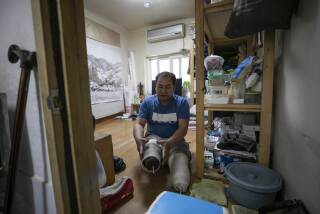Hong Kong’s Squalid Walled City Resists Razing : Housing: The government plans to have all residents out by 1992 so the ramshackle buildings can be torn down. Some say they do not want to go.
- Share via
HONG KONG — There is not much to keep Cheung Sam-mui in the tiny, faded room where she has lived and worked as a prostitute for the last six years.
However, when the timid, wizened 54-year-old woman packs up her bags to be resettled by the Hong Kong government early next year, it will be one of the few times in her life she has left the Kowloon Walled City.
“I was born here and spent my whole life here,” she said, smiling shyly and straightening her hair self-consciously. “I don’t know what I’ll do on the outside.”
The government’s 1984 decision to raze the Walled City meant radical changes for the 30,000 residents of the squalid slum near Hong Kong’s international airport.
It also brings down the curtain on an era that Hong Kong’s colonial government would rather forget.
Because of a territorial dispute after China’s cession of Hong Kong to Britain in 1898, the Walled City developed over the last century into a lawless no man’s land.
Its dank, winding alleyways became the gathering place of criminals and drug addicts, gamblers and prostitutes, unlicensed doctors and dentists.
Buildings rose up in defiance of housing codes, with exposed electric wiring running along the ceilings and water dripping from pipes tapped illegally into government tanks.
The government, fearful of antagonizing Beijing, which also claimed jurisdiction over the city, allowed the seven-acre enclave to fester on, virtually unpatrolled and ungoverned.
“The Walled City has been a bit of an embarrassment through the last few decades,” acknowledged Philip Chok, Hong Kong’s Deputy Secretary of Home Affairs. “But we’re intent on getting rid of this cancer in the heart of the territory.”
Talks between Beijing and London on Hong Kong’s future paved the way in 1984 for a partial resolution of the dispute. It was agreed that the slum would be destroyed and replaced by a neutral park until the whole of Hong Kong returns to Chinese rule in 1997.
Since the government began the resettlement program in December, 1987, about half the Walled City’s residents have moved to government housing elsewhere in Hong Kong. Officials expect the remainder to go by the middle of 1992.
The project is expected to cost $397 million, including demolition of the slum and compensation for its residents.
Most residents have welcomed the chance to move out of the ghetto, where buildings stand so close together that little light reaches the streets and the fetid air is undisturbed by any breeze.
For others, resettlement is not only undesirable but can prove traumatic.
“Some residents lived for tens of years in the Walled City, with all of their friends and relatives there too. They are facing real problems trying to adjust to a new place,” said Li Tak-hong, a former resident and secretary of a new Walled City support group.
“I cried when I heard the news,” said a 36-year-old housewife who had moved into a tiny flat in the city three years ago to save money.
“I didn’t know where I would move, where I could afford to move, or where my kids would go to school.”
Businesses, which have benefited from cheap rent and a long tax holiday in the ghetto, have voiced the loudest opposition.
“We pay 2,500 Hong Kong dollars (about $320) in rent a month for a 1,000-square-foot room, but we couldn’t find one for double that price outside,” said a worker at a silk flower-making factory, which was the only sign of life in a maze of dark, abandoned flats.
He said the company planned to stay despite the government’s orders to leave.
For the few hundred unlicensed medical practitioners in the Walled City, moving out almost certainly will mean looking for a new job.
“I’ve worked here for 10 years,” said a 37-year-old dentist from China as he sat in his one-room office amid rows of plastic model teeth and a large color television.
“My father was a dentist before me in Guangdong, but I don’t have a license and I wouldn’t be able to practice dentistry outside.”
More to Read
Sign up for Essential California
The most important California stories and recommendations in your inbox every morning.
You may occasionally receive promotional content from the Los Angeles Times.













